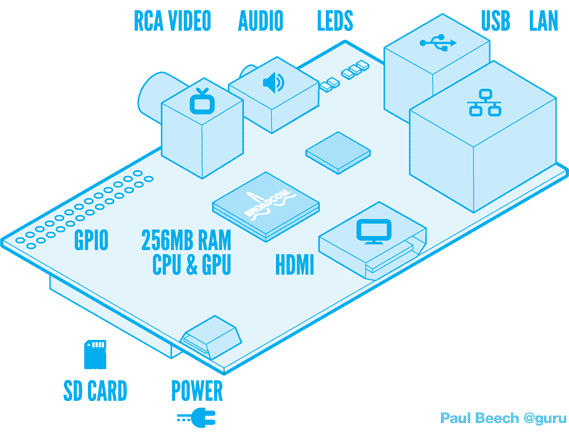 The Raspberry Pi is a credit card sized single-board computer developed in the UK by the Raspberry Pi Foundation with the intention of stimulating the teaching of basic computer science in schools.
The Raspberry Pi is a credit card sized single-board computer developed in the UK by the Raspberry Pi Foundation with the intention of stimulating the teaching of basic computer science in schools.
The Raspberry Pi has a Broadcom BCM2835 system on a chip (SoC), which includes an ARM1176JZF-S 700 MHz processor,VideoCore IV GPU, and 256 megabytes of RAM. It does not include a built-in hard disk or solid-state drive, but uses an SD card for booting and long-term storage.
Available two versions Priced at US$ 25 and US$ 35.
The Foundation provides Debian and Arch Linux ARM distributions for download. Also planned are tools for supporting Python as the main programming language, with support for BBC BASIC, (As "Brandy Basic", the BBC BASIC clone), C, and Perl.
 HARDWARE:
HARDWARE:
Initial sales are of the Model B, with plans to release the Model A sometime later. Model A has one USB port and no Ethernet controller, and will cost less than the Model B with two USB ports and a 10/100 Ethernet controller.
Though the Model A doesn't have an RJ45 Ethernet port, it can connect to a network by using a user-supplied USB Ethernet or Wi-Fi adapter. There is in reality no difference between a model A with an external Ethernet adapter and a model B with one built in, because the Ethernet port of the model B is actually a built-in USB Ethernet adapter. As is typical of modern computers, generic USB keyboards and mice are compatible with the Raspberry Pi.
 The Raspberry Pi does not come with a real-time clock, so an OS must use a network time server, or ask the user for time information at boot time to get access to time and date for file time and date stamping. However, a real-time clock (such as the DS1307) with battery backup can be added via the I2C interface.
The Raspberry Pi does not come with a real-time clock, so an OS must use a network time server, or ask the user for time information at boot time to get access to time and date for file time and date stamping. However, a real-time clock (such as the DS1307) with battery backup can be added via the I2C interface.Operating Systems
This is a list of operating systems running, ported or in the process of being ported to Raspberry Pi
- Full OS:
- Arch Linux ARM
- Debian Squeeze
- Gentoo Linux
- Google Chrome OS
- Raspberry Pi Fedora Remix
- Raspbian
- RISC OS
- Slackware ARM (formally ARMedslack)
- QtonPi a cross-platform application framework based Linux distribution based on the Qt framework
- NetBSD
- Multi-purpose light distributions:
- Squeezed Arm Puppy, a version of Puppy Linux (Puppi) for the ARMv6 (sap6) specifically for the Raspberry Pi.
What’s a Raspberry Pi?
The Raspberry Pi is a credit-card sized computer that plugs into your TV and a keyboard. It’s a capable little PC which can be used for many of the things that your desktop PC does, like spreadsheets, word-processing and games. It also plays high-definition video. We want to see it being used by kids all over the world to learn programming.

What’s the difference between Model A and Model B?
Model A has 128Mb of RAM
Model A has been redesigned to have 256Mb RAM, one USB port and no Ethernet (network connection). Model B has 256Mb RAM, 2 USB port and an Ethernet port.
What are the dimensions of the Raspberry Pi?
The Raspberry Pi measures 85.60mm x 53.98mm x 17mm, with a little overlap for the SD card and connectors which project over the edges. It weighs 45g.
What SoC are they using?
The SoC is a Broadcom BCM2835. This contains an ARM1176JZFS, with floating point, running at 700Mhz, and a Videocore 4 GPU. The GPU is capable of BluRay quality playback, using H.264 at 40MBits/s. It has a fast 3D core accessed using the supplied OpenGL ES2.0 and OpenVG libraries.
Why did they select the ARM11?
Cost and performance.
How powerful is it?
The GPU provides Open GL ES 2.0, hardware-accelerated OpenVG, and 1080p30 H.264 high-profile decode.
The GPU is capable of 1Gpixel/s, 1.5Gtexel/s or 24 GFLOPs of general purpose compute and features a bunch of texture filtering and DMA infrastructure.
That is, graphics capabilities are roughly equivalent to Xbox 1 level of performance. Overall real world performance is something like a 300MHz Pentium 2, only with much, much swankier graphics.
Will it overclock?
There’s a little overclocking headroom – most devices will run happily at 800MHz. There’s no BIOS per se, but we do support booting bare metal code, so something could be done.
Can we add extra memory?
No. The RAM is a POP package on top of the SoC, so it’s not removable or swappable.
Is sound over HDMI supported?
Yes.
Is there a GPU binary?
Yes. The GPU binary also contains the first stage bootloader.
Can we add a touchscreen?
We haven’t experimented with any touchscreens yet, but there’s no electronic reason why it shouldn’t work. There’s lots of discussion about this on the forums. The main issue people are encountering seems to be one of cost; touchscreens are very pricey!
No comments:
Post a Comment